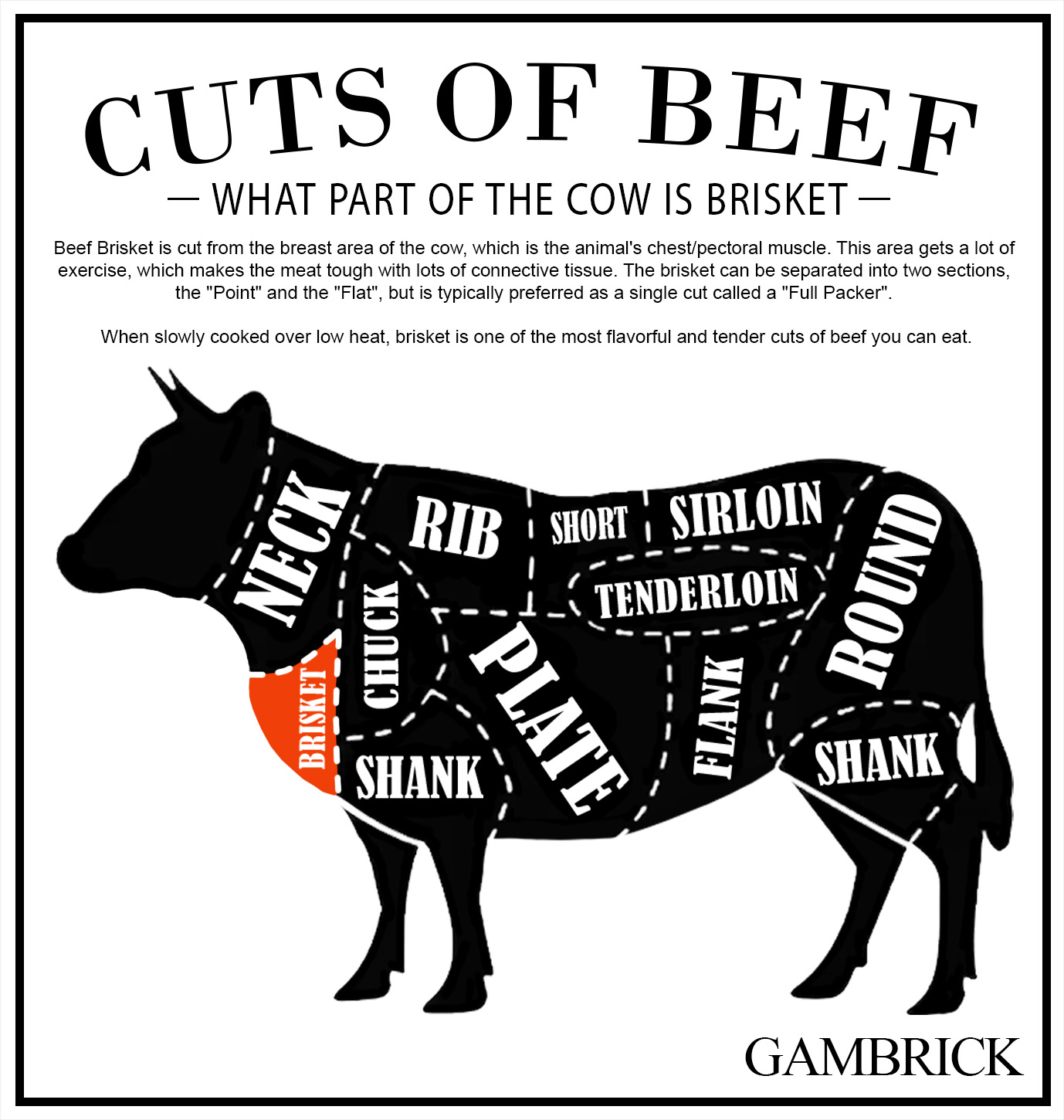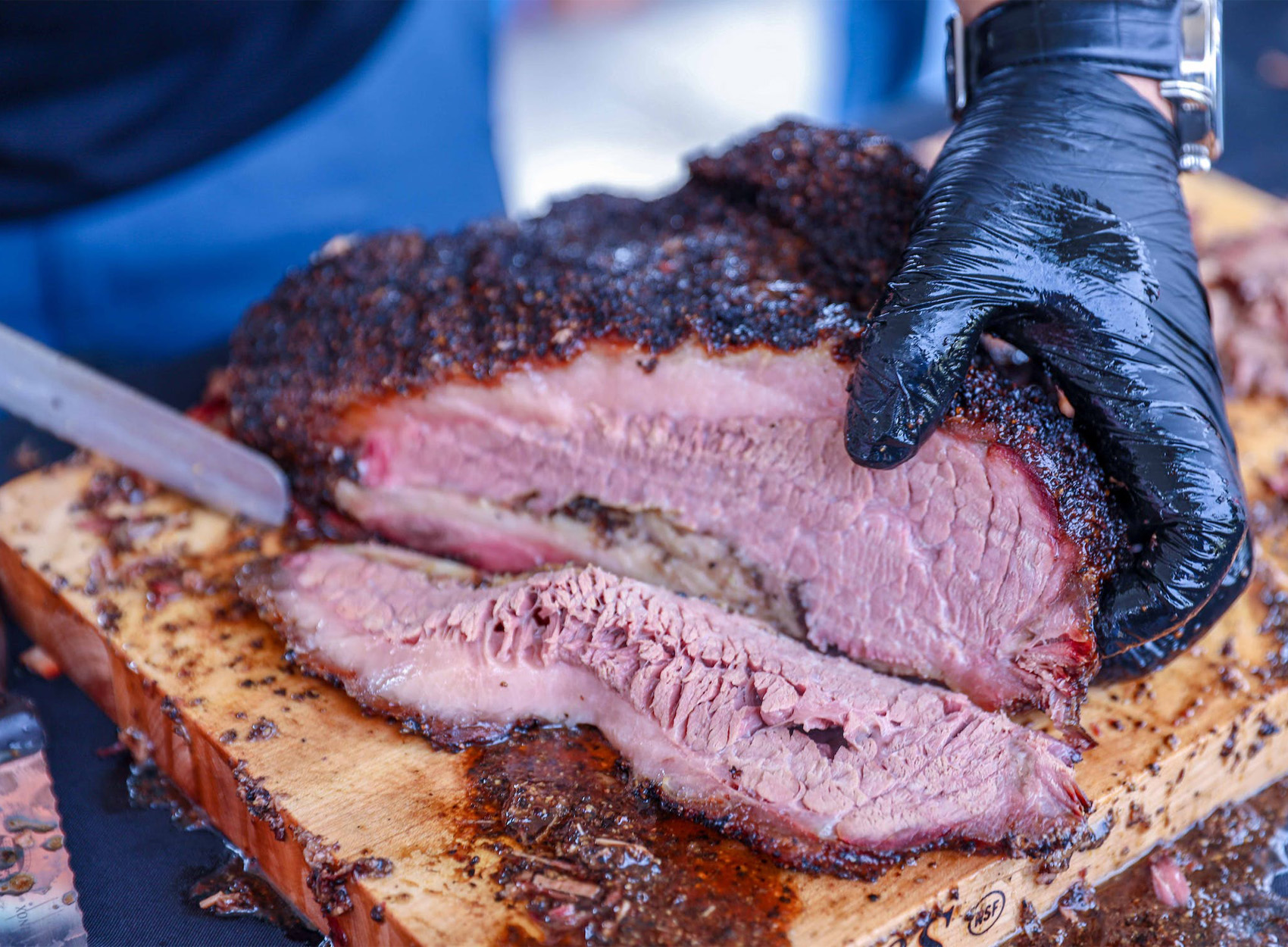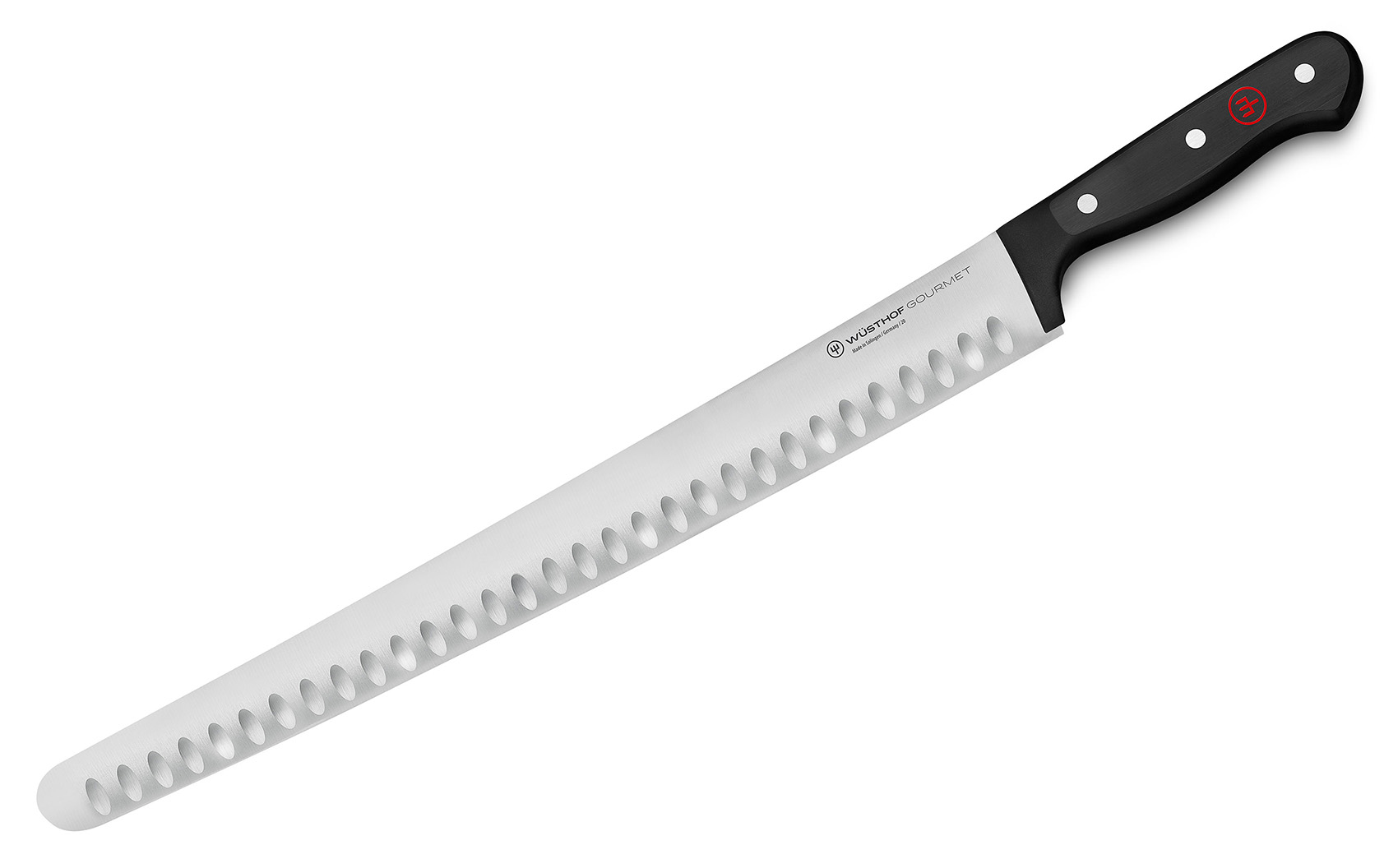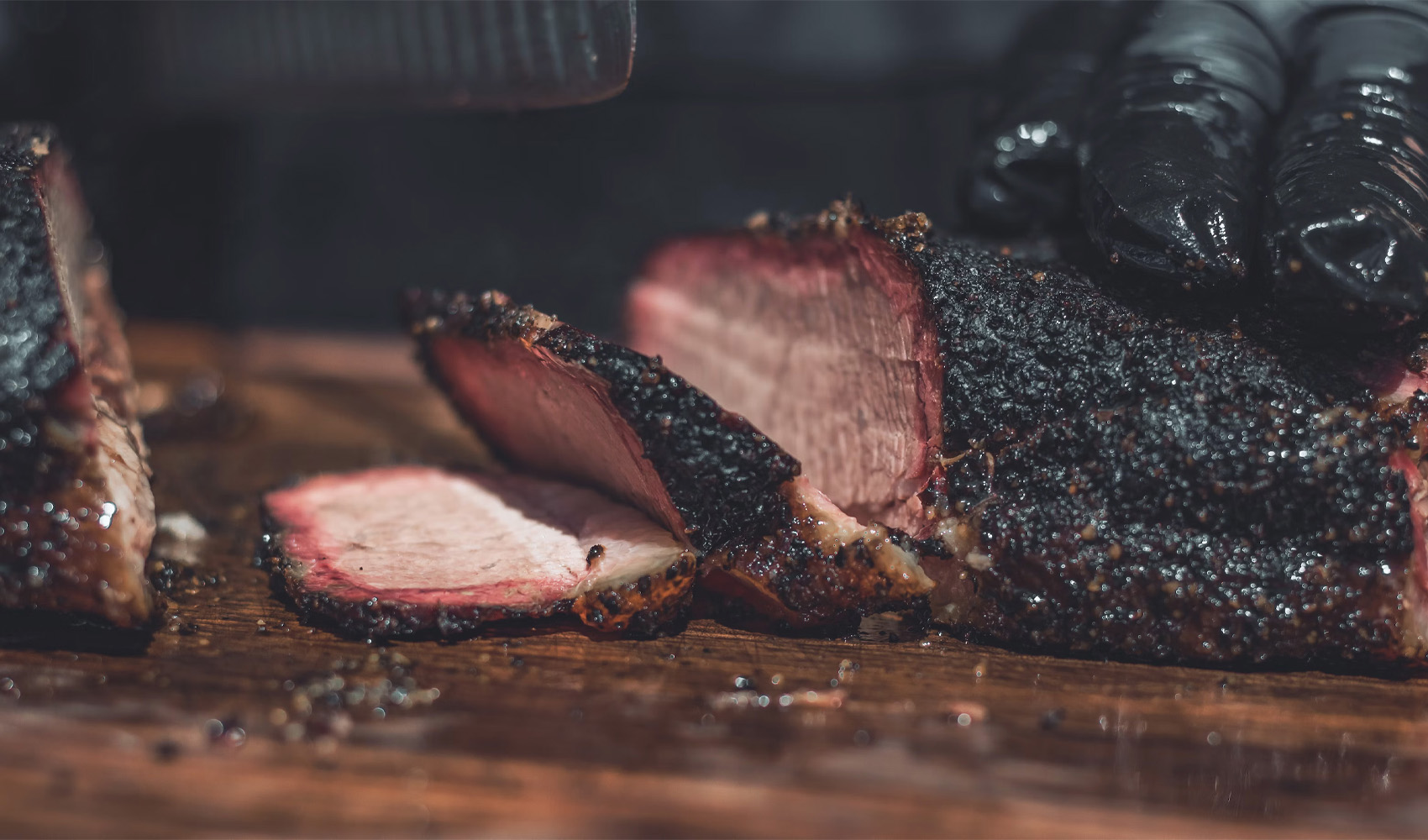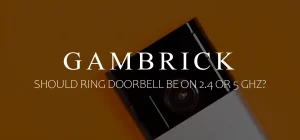What Part Of The Cow Is Brisket?
Beef Brisket is cut from the breast area of the cow, which is the animal’s chest/pectoral muscle. This area gets a lot of exercise, which makes the meat tough with lots of connective tissue. The brisket can be separated into two sections, the “Point” and the “Flat”, but is typically preferred as a single cut called a “Full Packer”. When slowly cooked over low heat, brisket is one of the most flavorful and tender cuts of beef you can eat.
Beef Brisket is a heavily used muscle so it can be tough if you cook it the wrong way. It’s best when cooked “low and slow” with a good rub and served with sauce. As it slowly cooks, the fat renders which tenderizes the meat producing a very tender and juicy cut of beef.
Wagyu beef briskets are among the best you can buy because they have lots of marbled fat. The fat renders as the brisket cooks which adds fantastic flavor and tenderness to the meat.
Each cow only produces 2 to 4 briskets, which is one of the reasons why they’re so expensive. Wagyu beef brisket can cost $60 per pound, which is one of the most expensive briskets you can buy, but on average, they’re between $4 and $14 per pound.
The challenge with buying brisket is that you typically have to buy either the entire brisket, a half or quarter pieces. A whole brisket can easily weigh 20 lbs with a 10lb half and 5 lb quarters. Even if you buy a cheaper brisket it’ll still be expensive because of its weight.
A good brisket requires time and patience to barbecue just right. I recommend covering your meat with a thick rub and smoking it on low heat around 275°F for 30-60 minutes per pound.
What Dishes Use Beef Brisket?
Beef brisket is most commonly prepared smoked and served sliced with a sauce and a side dish of coleslaw, potatoes, beans or a vegetable. But its actually a versatile cut of beef that’s used in a number of other dishes.
Most people prepare brisket braised or smoked, but it’s also the meat used to make corned beef and pastrami. It’s also used as a pot roast, in stews, as a sandwich meat, in Vietnamese Pho and Italian bollito misto. You can also grind brisket up and cook it as a meatball in red tomato sauce.
One of my favorite ways to cook brisket is in a chili. The slow cook and chili sauce breaks down the brisket’s fat and tenderizes the meat until it becomes melt-in-your-mouth soft and juicy.
How To Buy Beef Brisket?
A beef brisket is the breast of the cow, which is its pectoral muscle. Overall, the meat is tough, fatty and has some connective tissue. Typically, brisket is sold as an entire chunk of beef, as a half brisket or in quarters. An entire brisket can easily weigh over 20 lbs, so for most people a 1/2 or 1/4 cut is more than enough meat.
It’s important to know what to look for when buying a brisket so that you get the highest quality meat and don’t overbuy. Because of how heavy brisket is, the meat could be very expensive, especially if you’re buying Wagyu or Kobe brisket.
Here are some tips I follow when buying my brisket:
Choose The Right Brisket Cut
The brisket is one of the nine primal cuts of the cow. Every cow has two briskets cut from the breast or lower chest of the animal, just below the chuck (shoulder). The muscles are used a lot which makes them tough with a lot of connective tissue, so you have to cook them correctly to make them tender.
There are two types of beef brisket known as the flat cut and the point cut. Together, they make up a whole beef brisket, which is sometimes known as a “Full Packer”.
- The point cut is the fatty part of the brisket, which is called the deckle. It has more marbling and is the more expensive cut.
- The flat cut, also known as “the first cut”, has the deckle removed, which makes it leaner and causes it to lay flat. It’s usually topped with a thick fat cap that needs to be trimmed a bit before cooking.
If you’re buying a whole brisket for your smoker, choose an untrimmed “Packer” cut. An untrimmed cut still has the point and the flat part together. The brisket should have an even fat cap with no gouge marks exposing the meat or trimmed off sections. The fat should be a nice white color and the meat should be red.
Most stores don’t sell untrimmed briskets so it’s best to buy one from a butcher.
If you’re buying smaller cuts, some people prefer the point cut because you get more meat and marbling, although it’s more expensive. Because the flat cut requires some trimming, you don;t get as much meat for the money, but it’s leaner meat which works better in some recipes.
When I cook brisket, I choose a cut that works best for the recipe I’m cooking.
Choose The Right Size
Brisket cuts can vary quite a bit in size and weight. When planning how much brisket to buy for your next BBQ, the rule of thumb I use is 1/2 pound per person. A “Packer” cut brisket, which is an entire untrimmed brisket, yields about 50-60% of its original weight depending on how it’s trimmed. Point cut briskets yield about 70-80% and flat cuts about 60%-70%.
I always buy a little more meat then I think I’ll need. Once you’ve trimmed the meat and smoked it, a lot of its weight will be reduced as the fat is either cut or melted away.
Appearance Matters
When shopping for a whole untrimmed brisket, pay attention to the color of both the meat and the fat. The brisket should be a deep and rich red with clean and white fat. If the meat has brown areas or the fat is a little yellow, don’t buy it.
When shopping for smaller cuts of brisket, inspect the color but also the marbling. You can’t see the marbling with a whole cut because it hasn’t been sliced in half yet. But with smaller cuts you can gauge how much marbling is in the meat. This can help you choose the right cut based on how you’re cooking the beef.
What Is Brisket Called At The Grocery Store?
What Is Brisket Called at the Grocery Store? A “Full-Packer” is a whole brisket that contains both the point and the flat cuts. A “Flat” or “Point” is just the flat or point cut of the whole brisket These may also be called “Half” briskets. Sometimes you’ll see packages of meat that are simply labeled “Brisket” with no further description. In this case, you can tell if it’s a whole or half brisket by its size. If it’s a half size, the flat cut will have a fat cap and the point cut will have more marbling.
A brisket may also be labeled as Corned Beef or Corned Brisket. And it’s sometimes refereed to as a “Pot Roast”, because of the way you slow cook it in a pot.
When in doubt, visit a butcher, a Costco or a grocery store that has a butcher on staff and ask. At many locations they’ll not only help you choose the right cut but can help you trim it properly too.
Is Brisket A Good Cut Of Meat?
Brisket is an excellent cut of meat and one of the very best for barbecue. The meat is juicy and very flavorful but naturally tough with lots of connective tissue, so it needs slow cooking over low heat. Cooking brisket for 8-10 hours in a smoker, dutch oven or slow cooker generally works best. If done right, the meat will be very flavorful, juicy and melt-in-your-mouth tender.
Brisket is a very good cut of meat if you plan on smoking or slow cooking it for hours. But if you want a tradition steak dinner, it’s not the best. The meat will be tough and chewy if you don;t prepare it the right way.
How Many Briskets Are On A Cow?
Cows typically have just two briskets, one on each side of the animal. But depending on the breed and size of the cow, there may be three to four briskets per cow. That’s only around 50 to 75 pounds of meat per cow, on average. Considering an average cow provides around 400 to 500 pounds of beef, brisket is scarce at less than 10% of the animal’s total beef supply.
Brisket is sold either as a whole piece, which is sometimes called a “Full Packer” or in pieces called the “Point” or the “Flat”. There are typically 2 to 4 whole briskets per cow, 2 to 4 “Point” and 2 to 4 “Flat” cuts.
Some butchers will also sell small quarter sized briskets around 5 pounds each, which is around 10 to 15 per cow.
Should You Trim The Fat Off Brisket?
Before cooking a brisket, you should trim off most of the fat cap. It’s too thick to fully render when you cook the meat low and slow which is necessary to make a brisket tender. If you don’t trim the excess fat, your meat will have large chunks of fat which will need trimming before you serve it.
The key is to remove some of the fat, but not all of it. I try to leave about 1/8th of an inch of fat at most, anything more I trim off before cooking. A thin layer of fat adds flavor when it renders and makes the meat even more tender.
When cooking Wagyu or Kobe brisket, you can trim even more fat off than usual because they have lots of marbling that renders from the inside.
The Best Ways To Cook Beef Brisket?
The best way to cook beef brisket is low and slow. Brown the meat in a small amount of oil over medium-high heat or sear it fat side up in a preheated 500˚F oven for 20 minutes per side to develop flavor. Add a small amount of liquid (water or broth) to a Dutch oven, cover tightly, and simmer over low heat or in a 275˚F oven for about 1 hour per pound.
Smoking brisket is my favorite way to cook it but it takes a long time to do it right. Here’s how:
- Coat the meat with your favorite Rub
- Wrap it in plastic wrap and place it in the refrigerator for 12-24 hours.
- Set your grill to 225˚F and preheat, lid closed, for 15 minutes.
- Place your brisket on the grill fat side down and cook for approximately 30-60 minutes per pound or until the internal temperature reaches 160˚F.
- Remove your brisket from the grill and wrap it in butcher paper or foil.
- Place the wrapped brisket back on the grill and continue cooking until the internal temperature reaches 200˚F. This usually takes an additional 3-4 hours.
- Remove the brisket from the grill and let rest for about an hour.
- Slice against the grain and serve.
Brisket is cut from the chest muscle of the cow, which is tough meat that has connective tissue. Cooking the meat slowly over low temperatures breaks down the meat’s fibers and renders the fat which creates tender and juicy beef. As a result, cooking brisket properly will take hours.
1. Smoked Brisket
One of the best, and most popular, ways to cook brisket is with a smoker. A smoker cooks brisket with low heat for a long period of time which is perfect for making the meat tender. It also adds a fantastic smokey flavor to the beef which is impossible to do with other cooking methods. Two of my favorites are apple or cherry wood.
The first step when smoking brisket is the seasoning. Cover the meat in your favorite rub or keep it simple with some salt, pepper and garlic powder. Wrap the meat in plastic and place it in the fridge for 12-24 hours and let the spices sink in.
Preheat your grill to 225˚F with the lid closed for 15 minutes. Place your brisket in the smoker and let it slow cook for 30-60 minutes per pound or until the internal temperature reaches 160˚F. Then remove the meat and wrap it in butcher paper or foil.
Place the wrapped brisket back on the heat and continue cooking for another 3-4 hours until the internal temperature reaches 200˚F.
Remove the brisket and let it rest for about an hour. During this time the juices will make the meat even more tender.
Finally, slice the meat against the grain and serve with a sauce, beans, rice, potatoes or a vegetable.
I recommend checking the internal temperature with a meat thermometer to make sure it’s properly cooked rather than sticking it with a fork or slicing it to look inside. A thermometer is accurate and doesn’t dry out the meat.
2. Slow Cooker
A slow cooker (crock-pot) is one of the best ways to cook brisket because its very hands off. Brisket requires low heat for a long period of time in order for the meat to become tender, which is exactly what a slow cooker does best.
Start by season the meat with your favorite rub. You can also cover the meat in some barbecue sauce. Add some liquid for braising in the slow cooker, broth, wine or plain water all work fine. Place the entire brisket in the pot and let it slow cook on 225˚F for about 1 hour per pound. You can also cook down other ingredients in the slow cooker to create a serving sauce.
Check your brisket every hour or so. You want the meat tender but not too soft. Once it’s ready, let the meat rest for about 15-20 minutes before serving.
3. Pot Roast
Cooking brisket as a pot roast is very similar to cooking it in a slow cooker. The only difference is that you’ll be used a dutch oven instead of a crock-pot and that you brown the meat before putting it in the oven.
Start off by browning the meat for around 5 minutes per side starting with the fat side down. I use a skillet to brown my brisket but you can also do it in the dutch oven. Next, season the meat with your favorite rub as you preheat the oven to 225˚F.
Add some liquid to the pot for braising, broth, wine or plain water all work fine. I like to add some vegetables like carrots, onions, garlic and potatoes into the pot too. If you add tomatoes you can create a sauce.
Place the pot in the oven and let it slow cook for around 1 hour per pound of beef.
Check your brisket every hour or so. You want the meat tender but not too soft. Once it’s ready, let the meat rest for about 15-20 minutes before serving. The liquid in your pot can be served as is or cooked down to make a thicker sauce. A little flour can help thicken the sauce up if your in a hurry.
4. Brisket Sous Vide
Cooking brisket sous vide is a non-traditional method, but it works really well and creates some very tender, juicy and flavorful beef.
Start by working the beef with your favorite rub. I let then cover the meat in plastic and let it sit in the fridge for a few hours. During this time, the spices and salt work their way into the meat.
Next, add liquid smoke and vacuum seal the entire brisket. Set your precision cooker to 135°F (57°C) and add the brisket to a water bath. Allow the meat to cook for 24 to 36 hours, until it has reached the desired level of tenderness.
Brisket is naturally a tough cut of beef that needs time to break down muscle fibers and connective tissue. Sous vide works really well because it’s a slow cook on low heat with moisture, which is exactly what tough brisket meat needs to become tender.
Can You Make Corned Beef At Home?
Yes, you can make corned beef at home with brisket, but but it takes days to do it right. What you need are a beef brisket, pickling spices, salt, and 5 days to allow the meat to cure.
Corned beef is essentially just beef brisket cured in a salt brine with some pickling spices for added flavor. It’s a very easy dish to make, but it takes time because the meat has to cure properly. If you try to rush the process, the meat won’t fully cure, it won’t taste right and the color will be off.
Here’s how to do it:
- Make a salty curing brine: Add pickling spices in your brine like mustard seed, allspice berries, coriander seeds, and peppercorns.
- Marinate your beef brisket in the brine: Let the meat soak in the brine, in a fridge, for 5 to 7 days.
- Simmer the brisket: Remove the brisket from the brine bath and let it drain. Then let it slowly simmer in water with more pickling spices for a few hours until it’s tender.
Soaking the corned beef in brine will make it tender because the muscle fibers and connective tissue breaks down and softens. Flip the brisket over to the other side every day so the brine soaks into the meat evenly.
Once the meat is fully tender and cooked properly, let it rest, covered in foil, for about an hour. Then slice and serve.
How To Slice Brisket The Right Way?
Slicing brisket properly is very important if you want the meat to be as tender as possible.Each slice must be made against the grain to make break down the muscle fibers easier as you chew. Slicing with the grain, makes the meat harder the break down which feels chewy.
Here’s how to do it:
Let The Brisket Rest
Never cut brisket immediately after removing it from the heat. It takes time for juices to redistribute throughout the beef which makes it even more tender and juicy. If you cut the meat too soon, juices will run which dries out the meat.
- If you’re serving your brisket hot, let it rest for 15-20 minutes before slicing.
- If you’re serving brisket cold, let it rest for at least an hour.
Don’t slice your brisket until you’re ready to eat. While the meat is whole it holds onto more of its moisture. Once the meat is sliced, juices run and air starts to dry the meat out. This slowly makes it less juicy, tough and dry.
Use A Sharp Knife
Slice brisket with a long sharp knife, at least 12-inches, with a serrated or scalloped blade. A long and sharp blade ensures the meat will be cut cleanly and not torn up. If there are tough areas, then the serrated or scalloped edge will cut right through in a single pass.
When you cut brisket, use long sweeping motions instead of quickly jerking the knife back and forth. The longer the cuts the less you’ll tear up the meat. What you’re looking for is very clean and sharp cuts.
My personal favorite is the Wüsthof Gourmet 14-Inch Brisket Slicer. It’s an expensive knife, but it’s super sharp and designed specifically for cutting through brisket.
Slice Against The Grain
Before you start slicing your brisket, trim off any large chunks of fat from the edges. Unless you like eating the fat, it’s generally best to clean the meat up a little before serving.
Always slice brisket with a long sharp knife preferably with a serrated or scalloped edge, against the grain. The connective tissue of beef brisket can be tough and difficult to break down when you chew. To make chewing easier, you shorten the muscle fibers by cutting against the grain.
- Cutting brisket with the grain makes it more tender and easier to chew.
- By cutting along the grain, you don’t shorten the muscle fibers so the only way to break them down is with your teeth. This makes the meat feel chewy.
The first thing you need to do is find the grain. I do it by cutting a small corner of the brisket to see which direction the muscle fibers are running. Once I know how the grain is running, I spin the meat so the the grain is parallel with by body and start slicing.
- Trim excess fat off the brisket.
- Make a small cut on an edge to identify the direction of the grain or if you cooked a whole brisket, cut it in half to separate the flat from the point.
- Spin your meat with the grain positioned 90˚ to your body.
- Slice your brisket “Flat” and “Point” against the grain.
- Serve
Watch the grain as you slice because it can change direction as you cut your way through the brisket.
Cut the meat gently with long strokes to avoid tearing the meat. Using a long sharp knife with the right edge will help a lot, especially if you run into a tough section of meat.
Save The Burnt Ends
Make sure to save the brisket’s burnt ends because they’re very tasty. Save the burnt ends, cover them in your favorite rub, then toss them in a boll of barbecue sauce mixed with a little beef stock and 1/2 cup of dark brown sugar. The slow cook them in the oven at 225˚ for about an hour and serve.
Burnt ends are tender and delicious when seasoned and cooked again. They’re like little nuggets that can be eaten as is but my favorite is serving them on a sandwich or with some corn bread.
My favorite thing to do with the burnt ends is to chop them up into small bits and mix them into mac and cheese. I then serve the mac as a side with my sliced brisket. It’s a delicious combo that I recommend you try at your next family barbecue.
How To Serve Brisket?
Brisket is best served with a side dish like mashed potatoes, coleslaw, corn on the cob, beans, as a sandwich, in a chili, a stew, etc. There’s no single best way to serve brisket which is one of the reasons why the meat is so popular. It’s a very versatile meal to make and easy to cook.
Potato salad is another very popular side that goes great with brisket but my personal favorite is mac and cheese. I serve mac and cheese on the side of my brisket but I also chop up and mix a few of the burnt ends into the mac and cheese. It’s a delicious meal that I recommend you try at your next barbecue.
How To Store Cooked Brisket
If you aren’t planning on eating your brisket right away, don’t slice it. Cutting a brisket too soon lets the juices run and the air in, which dries out the meat. Instead, let the meat sit whole and uncut, in its own juices. During this time, the meat will absorb more flavor and become more tender.
When you’re ready to store the meat in a fridge, you can either leave the meat whole or slice it.
Here’s how to do both:
Whole: If you plan on storing your brisket whole, remove it from its liquids, then place it in a dish and wrap it in foil. Don’t store the meat in liquid. I prefer to store my briskets whole because it preserves more of its juices.
When you’re ready to eat the meat, you can either reheat it or let the meat reach room temperature before slicing.
Sliced: Some people prefer slicing the brisket before storing it in the fridge. This makes eating small amounts easier because you can take out a few slices whenever you want. I don’t do it this way because the meat becomes drier. Once you’re done slicing, cover the meat in foil to preserve as much moisture as possible.
I save the sauces and juices from the dish I cooked the meat in for use later. This is where all the best flavors are so I don;t like throwing it out. I like to reheat and drizzle some on top of my meat before serving or use it as a dip.
How To Reheat Brisket
When it comes time to reheat stored cooked brisket, you have two main options:
- The first is to place slices of meat in a pan or skillet and heat them up. I like to also add some fat to the pan, butter is my favorite, and some of the juices I cooked the meat in.
- If your brisket isn’t sliced, reheat it whole in the oven. Add some liquid to the pan like broth or a wine. Slowly heat the meat at around 225˚ for an hour or so. Then remove the meat from the pan and slice.
I don’t recommend using a microwave to reheat brisket because it makes the meat dry and chewy. But it works if you’re in a rush.
Why is Brisket So Expensive?
Why is brisket so expensive considering it’s a fairly tough cut of beef with lots of connective tissue? Usually the rule with beef is, the more tender the cut the more expensive it is, the tougher the cut the cheaper it is. But brisket is expensive because it’s in high demand and the meat is scarce.
Cows typically have just two briskets, one on each side of the animal. But depending on the breed and size of the cow, there may be three to four briskets per cow. That’s only around 50 to 75 pounds of meat per cow, on average. Considering a typical cow provides around 400 to 500 pounds of beef, brisket is scarce at less than 10% of the animal’s total beef supply.
Then there’s demand to consider. Beef brisket is used in a variety of dishes ranging from barbecue and sandwiches to stews, chili and even meatballs. Just about every country and style of cooking that uses beef, wants brisket. With more demand comes a higher price per pound.
Another issue is the size of each brisket cut. Typically it’s sold as a while brisket, a half or in quarters. Stores and butchers don’t typically sell small brisket steaks, so large portions coupled with high demand and scarcity means higher prices.
Basically, the reason why brisket is so expensive is supply and demand. There isn’t much brisket meat per cow, the servings are large and the demand is high, so the price is higher per pound than many other beef cuts.
Summary: What Part Of The Cow Is Brisket?
Beef Brisket is cut from the breast area of the cow, which is the animal’s chest/pectoral muscle. This area gets a lot of exercise, which makes the meat tough with lots of connective tissue. The brisket can be separated into two sections, the “Point” and the “Flat”, but is typically preferred as a single cut called a “Full Packer”. When slowly cooked over low heat, brisket is one of the most flavorful and tender cuts of beef you can eat.
Beef Brisket is a heavily used muscle so it can be tough if you cook it the wrong way. It’s best when cooked “low and slow” with a good rub and served with sauce. As it slowly cooks, the fat renders which tenderizes the meat producing a very tender and juicy cut of beef.
- Wagyu and Kobe beef brisket are among the best you can buy because they have lots of marbled fat.
- Each cow only produces 2 to 4 briskets, which is one of the reasons why they’re so expensive.
- Wagyu beef brisket can cost $60 per pound, which is one of the most expensive briskets you can buy.
- On average, brisket costs between $4 and $14 per pound.
The challenge with buying brisket is that you typically have to buy either the entire brisket, a half or quarter pieces. A whole brisket can easily weigh 20 lbs with a 10lb half and 5 lb quarters. Even if you buy a cheaper cut of brisket it’ll still be expensive because of the beef weight.
I recommend covering your meat with a rub and smoking it on low heat around 275°F for 30-60 minutes per pound.
If you have any questions or comments about beef brisket, email any time.

